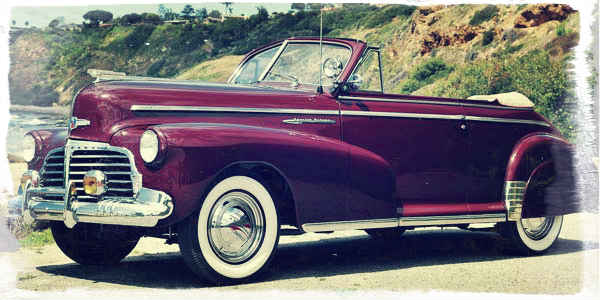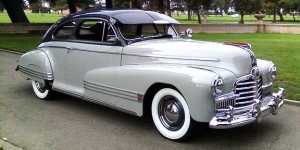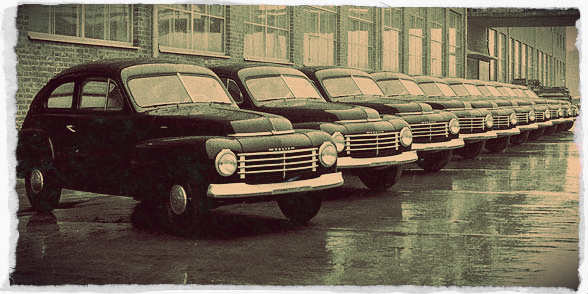
Cars in the 1940s were much more streamlined than cars in the ’30s. Also many improvements were made to conserve materials.
Because of WWII, many changes had to be made. Shortages in materials like aluminum, zinc and copper forced carmakers to go back to cast-iron and steel. However, the cars still got bigger and more luxurious.
You can clearly see the transition auto manufacturers went through to get from the 30s to the 50s. And even though they were beasts, cars in the 1940s typically got between 15 and 20 MPG.
Cars from the 1940s in good condition, especially convertibles, are extremely valuable now. Simply put, they command attention rolling down the street.
Keep scrolling down for pictures and more information.
Cars in 1941

In 1941 the automotive industry began to feel the full impact of the rearmament program. There was no formal announcement of the 1942 models. Design of the 1941 models was not frozen because of much retooling had been completed before the limitations of the defense program were evident and because re-design was required to replace critical materials such as nickel, aluminum and zinc.
Early in 1941 it became evident that production curtailment of passenger cars would be necessary to save materials for defense purposes. The original production program for the 1942 model year called for a tentative curtailment of at least 50%.
During the first seven months of the 1942-model year, allotments were reduced 39.7% with respect to the same period in the 1941-model year.
National defense became the dominant factor in the automotive industry during in 1941. Defense contracts totaled over $4 billion. Many new plants had to be build to fit the parts for the military vehicles they were now building.

The 1942 Pontiac Streamliner was the only new model introduced in 1941
Motor vehicle production and sales increased over the previous year.
Transmission improvements continued to be the foremost mechanical trend. They were made with the purpose of permitting more effective use of a gear ratio with consequent increase in economy as well as acceleration and simultaneously eliminated most of the manual gear shifting usually required.
Because of the rearmament program, many change were made to the engines of the 1942 models. Aluminum for pistons was replaced by cast iron or steel.
Continuing the trend set several years before, the 1942 models looked larger, lower and more massive. Wheelbases and overall lengths were slightly increased but the principal reason for this was improved design. Long, sweeping lines were achieved by expanding the front fender into the door. Radiator grills were wider, bumpers were heavier and curved around the fenders.
Hoods were broader and more rounded in front. Headlamps were father apart and one model even had recessed headlights that were covered by sliding panels that were controlled by a knob on the instrument panel.
By the 1942 model year, running boards were either absent or concealed by the door. Streamlined bodies offered a couple more inches of headroom in the back. Heating and ventilation systems were the object of general improvement and nearly all models provided fresh air intakes. Decorative plating which appeared on the early 1941 models were discontinued to conserve nickel and copper.
Cars in 1943

Let’s be honest, 1943 was in the heart of World War II. All hands were on deck, meaning everyone was helping to build military might.
That included no one more than the automobile industry. Let’s put it this way, in 1943 the automobile industry produced over $10 billion in military equipment. That was more than DOUBLE what they made the previous year in auto sales. Building planes, tanks, trucks and anything else the US Government needed in their massive, efficient factories; the automobile industry was the MVP of WWII.
Maybe that’s a reason why our government is so eager to bail them out now.
No American car manufacturer introduced a new model in 1943. Only Japan and Germany did and they were incredibly tiny amounts. No one was really worried about buying a new car.
They were more concerned with building airplanes and tanks. As far as cars are concerned, WWII has shut down the industry.












